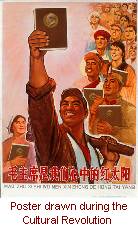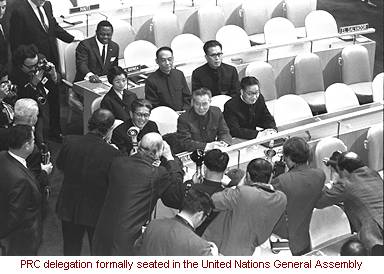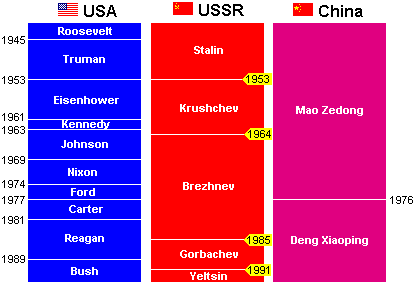|
|
|
|

|
China
|
At the end of World War II, both the Chinese Communist Party and the KMT (Kuomintang Nationalist Army) are rearmed, the KMT by the United States and the Communists by the Soviet Union. They renew their war.
In the summer of 1949, the Communist win the war against the KMT. On the 1st of October, the People's Liberation Army arrives in Beijing and establishes the People's Republic of China.
 Mao Zedong, chairman of the People's Republic of China, travels to Moscow. After two months of negotiations, China and the Soviet Union sign a treaty of mutual assistance accompanied by limited economic aid.
Mao Zedong, chairman of the People's Republic of China, travels to Moscow. After two months of negotiations, China and the Soviet Union sign a treaty of mutual assistance accompanied by limited economic aid.
Text
of the conversation between the Soviet Union's Joseph Stalin and China's Mao Zedong.
Communist China's plans to attack the KMT in Taiwan are thwarted when the United States, in an attempt to curb the spread of Communism, finances a military buildup on Taiwan.
China enters the Korean War, on the side of Communist North Korea. This brings China into direct confrontation with the United States, who is supporting non-Communist South Korea.
The Bandung Conference, a meeting of representatives of 29 African and Asian nations, is held at Bandung, Indonesia. China plays a major role in the conference, strengthening its friendly relations with other Asian nations. The aim of the conference is to promote economic and cultural cooperation amoung the Asian nations. Dissatisfaction was also raised against what is seen as the reluctance of Western powers to consult them on decisions affecting Asia.
Nikita Khruschev's de-Stalinization announcement at the 20th Congress of the Soviet Communist Party angers Mao Zedong, bringing antagonism into Sino-Soviet relations. Conflicts develop over domestic, foreign and defence policies, economic relationships, and ideological differences.
The Soviets decide to withdraw economic and military assistance from China. They also recall thousands of Soviet advisers from China. This comes as a serious blow to the economy of China which is barely recovering from the failure of the "Great Leap Forward". The ideological rift between China and the Soviet Union widens.
China openly condemns the Soviet Union for withdrawing its missiles from Communist Cuba and capitulating to pressure from the United States. Mao sees the following policy of "peaceful coexistence" between the Soviet Union and the United States as a betrayal to Communism.
Zhou Enlai tours Asia and Africa. This is a major milestone in the development of friendly relations between China and other Asian and African countries. China begins to compete with the Soviet Union for influence among the members of the Nonaligned Movement, a group of countries not allied with the United States or the Soviet Union.
The People's Republic of China explodes its first nuclear bomb.
Read about the evolution of China’s
Nuclear Nonproliferation Policy.
 Fearing that China would develop under the lines of Soviet Communism, Mao launches the Cultural Revolution to recapture the revolutionary zeal of early Chinese Communism.
Fearing that China would develop under the lines of Soviet Communism, Mao launches the Cultural Revolution to recapture the revolutionary zeal of early Chinese Communism.
Read more about the
Cultural Revolution.
Here's a site that offers a lot of information on the
Cultural Revolution.
China accuses Soviet leaders of imperialism after the Soviet-led invasion of Czechoslovakia. This worsens the Sino-Soviet tension.
 Military buildup along the border of the Amur and Ussuri rivers leads to clashes between Chinese and Soviet border guards. Emergency talks take place between Soviet premier Alexei Kosygin and Chinese Premier Zhou Enlai in September to stop hostilities. They agree to a formal demarcation of territory.
Military buildup along the border of the Amur and Ussuri rivers leads to clashes between Chinese and Soviet border guards. Emergency talks take place between Soviet premier Alexei Kosygin and Chinese Premier Zhou Enlai in September to stop hostilities. They agree to a formal demarcation of territory.
Here's more information on the
Sino-Soviet Conflict.
What else is the Amur-Ussuri region famous for? Answer: the
Siberian Tiger
In a move to improve relations with the United States, China invites the American Ping-Pong team to an all-expense paid trip to China.
 China is given the China seat in the United Nations, taking over the seat held by the nationalist government in Taiwan since 1945.
China is given the China seat in the United Nations, taking over the seat held by the nationalist government in Taiwan since 1945.
 President Richard Nixon makes an official visit to China during which he agrees to the eventual withdrawal of U.S. troops from Taiwan. After this visit, many other nations transfer their diplomatic recognition from Taiwan to China.
President Richard Nixon makes an official visit to China during which he agrees to the eventual withdrawal of U.S. troops from Taiwan. After this visit, many other nations transfer their diplomatic recognition from Taiwan to China.
Read about the
meeting
between President Nixon and Premier Chou En-lai
Mao Tse-tung dies, setting off a succession struggle in China.
A great way to know more about a person - read his writings. Here are some
writings
of Mao Zedong.
A
picture gallery
of Chairman Mao and the Chinese Revolution.
Deng Xiaoping is reinstated to a leadership post, taking on the role of deputy premier.
More on
Deng Xiaopeng.
The United States and China announce the restoration of full diplomatic relations.
The United States formalises relations with mainland China, and signs the Taiwan Relations Act which brings into effect a new relationship with Taiwan. The United States continues to treat Taiwan as an independent nation, sell it arms, and lend it money.
Soviet leader Mikhail Gorbachev visits Beijing to end the 30-year rift between the Soviet Union and China.
Students march in the capital to ask for freedom of the press, educational reforms, and an end to political corruption. This prodemocracy demostration in Beijing turns bloody when the protestors are killed and injured by government troops after refusing to leave the square.
Read a
chronology of events
that took place in Tiananmen Square.
Watch a CNN
movie
on the Tiananmen Square incident.
The Soviet Union and China sign the "Agreement on Guiding Principles for the Mutual Reduction of Military Forces Along the Sino-Soviet Boundary and the Strengthening Confidences in the Military." This agreement provides for a mutual reduction of troops along the border.
With the breakup of the Soviet Union in 1991, China becomes the only remaining major world power with a Communist government.
Look at some
posters
from China.
Leaders During Cold War

|
|




 Mao Zedong, chairman of the People's Republic of China, travels to Moscow. After two months of negotiations, China and the Soviet Union sign a treaty of mutual assistance accompanied by limited economic aid.
Mao Zedong, chairman of the People's Republic of China, travels to Moscow. After two months of negotiations, China and the Soviet Union sign a treaty of mutual assistance accompanied by limited economic aid.
 Fearing that China would develop under the lines of Soviet Communism, Mao launches the Cultural Revolution to recapture the revolutionary zeal of early Chinese Communism.
Fearing that China would develop under the lines of Soviet Communism, Mao launches the Cultural Revolution to recapture the revolutionary zeal of early Chinese Communism.
 Military buildup along the border of the Amur and Ussuri rivers leads to clashes between Chinese and Soviet border guards. Emergency talks take place between Soviet premier Alexei Kosygin and Chinese Premier Zhou Enlai in September to stop hostilities. They agree to a formal demarcation of territory.
Military buildup along the border of the Amur and Ussuri rivers leads to clashes between Chinese and Soviet border guards. Emergency talks take place between Soviet premier Alexei Kosygin and Chinese Premier Zhou Enlai in September to stop hostilities. They agree to a formal demarcation of territory.
 China is given the China seat in the United Nations, taking over the seat held by the nationalist government in Taiwan since 1945.
China is given the China seat in the United Nations, taking over the seat held by the nationalist government in Taiwan since 1945.
 President Richard Nixon makes an official visit to China during which he agrees to the eventual withdrawal of U.S. troops from Taiwan. After this visit, many other nations transfer their diplomatic recognition from Taiwan to China.
President Richard Nixon makes an official visit to China during which he agrees to the eventual withdrawal of U.S. troops from Taiwan. After this visit, many other nations transfer their diplomatic recognition from Taiwan to China.
